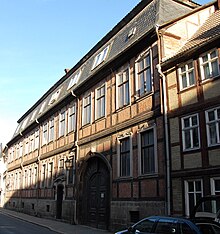Neuer Weg 7 (Quedlinburg)
The house Neuer Weg 7 is a listed building in Quedlinburg in Saxony-Anhalt .
location
The building, registered as a brickworks in the Quedlinburg monument register, is located south of the historic Quedlinburg old town, on the east side of the Neuer Weg. The house Neuer Weg 6 , which is also listed, is adjacent to the north , and the house Neuer Weg 8 to the south .
Architecture and history
As early as the Middle Ages , probably from the 14th century, the property served as a building yard and brickworks for the Quedlinburg Abbey and supplied the Abbey with building materials. The spacious courtyard had special rights for this. Clay and limestone were allowed to be quarried in the entire monastery area to meet urban needs.
The front building on the street side was built according to a building inscription in 1770 in half-timbered construction and is designed in the style of a palace. The compartments are provided with decorative lining. The windows are framed with Rococo style draperies. The gate in the southern half of the house is decorated with carvings. The house entrance door has console panels and a skylight . Findings on the previous coloring were found on the building. The infill and wood were then originally painted yellow, the profile plank and window frames painted sandstone gray.
There are remains of a gallery facing the courtyard, which is provided with carved pillars and parapet reliefs.
The courtyard wings of the property were partially changed through renovations.
The oldest building of the courtyard that has been preserved today is a wing at the rear of the courtyard. The wing made of ashlar masonry is dated to 1660, although its core is probably older. A small relief is remarkable.
During the Nazi period of tyranny, the SA headquarters was located in the building . At that time, the name SA barracks was popularly known . During the Reichspogromnacht on November 9, 1938, it was the starting point for a train of 30 to 40 SA members who devastated Jewish shops in Quedlinburg.
literature
- Falko Grubitzsch in: Georg Dehio : Handbook of German Art Monuments . Saxony-Anhalt. Volume 1: Ute Bednarz, Folkhard Cremer and others: Magdeburg administrative region. Revision. Deutscher Kunstverlag, Munich et al. 2002, ISBN 3-422-03069-7 , page 740.
- Falko Grubitzsch, Monuments Directory Saxony-Anhalt, Volume 7.1, City of Quedlinburg , State Office for Monument Preservation and Archeology Saxony-Anhalt, Flyhead Verlag Halle 1998, ISBN 3-910147-67-4 , page 191.
Individual evidence
- ↑ Hans-Hartmut Schauer, Quedlinburg, specialist workshop / world cultural heritage , Verlag Bauwesen Berlin 1999, ISBN 3-345-00676-6 , page 40
- ↑ Hans-Hartmut Schauer, Quedlinburg, specialist workshop / world cultural heritage , Verlag Bauwesen Berlin 1999, ISBN 3-345-00676-6 , page 40
- ^ Hans-Hartmut Schauer, Quedlinburg, specialist workshop / world cultural heritage , Verlag Bauwesen Berlin 1999, ISBN 3-345-00676-6 , page 147
- ↑ Hans-Hartmut Schauer, Quedlinburg, specialist workshop / world cultural heritage , Verlag Bauwesen Berlin 1999, ISBN 3-345-00676-6 , page 66
- ↑ Thomas Wozniak, Quedlinburg, Kleine Stadtgeschichte , Verlag Friedrich Pustet Regensburg 2014, ISBN 978-3-7917-2605-2 , page 115
Coordinates: 51 ° 47 ′ 12.7 " N , 11 ° 8 ′ 34.7" E

